Diamonds Should No Longer Be Priced Just in US Dollars
As economies around the world have changed dramatically and become more global concurrently with the US debt rising to its current levels, I suppose that it is irresponsible to keep trading diamonds only in US currency. I think that it should apply to many other various commodities, such as gold, oil, platinum, and all other basic consumption and manufacturing commodities as well. However, I will only address diamonds.
The question remains: in what currency should diamonds be priced? It would be tough to say, since all major currencies are valued against the US dollar. Some are being “monitored” and “controlled”, while others are allowed to fluctuate according to supply and demand. The fact that all major commodities trade automatically in US dollars gives the impression that the demand for US dollars is real, while in reality it may not be the case.
Many countries have slowly been decreasing their currency reserves of US dollars in favor of a more balanced basket of currencies. China is such a country. Who is right in their actions, China or the US? China has a strong arm in the valuation of their currency, while the US, which dominates the world in terms of size of economy, has debt that has ballooned to almost $20 trillion dollars.
I believe that the price of diamonds should follow a more balanced basket of currencies, which should rely on a country’s real wealth. I also believe that the pricing structure of diamonds should be a formula that includes the top 10 currencies changing hands.
What are the Top 10 Currencies Currently Dominating Global Trade?
According to Swift (the international entity enabling wire transfers), since August 2015, the USD (U.S. Dollar) has been dominating global trade with 44.82% of all global payments, followed by the EUR (the Euro) at a far second at 27.20%. In third place is the GBP (British Pound) at 8.45%, followed by the CNY (Chinese Renminbi) in fourth place at 2.79% (which also doubled since January 2014). Fifth place is held by the JPY (Japanese Yen) at 2.76%. The next 5 currencies are the Canadian Dollar, Australian Dollar, Swiss Francs, Hong Kong Dollar, and Thailand Bhat. All of these currencies trade at least 1% of global currencies payments each.
Let’s review how the top nine currencies have changed in value with the USD over the last 10 years.
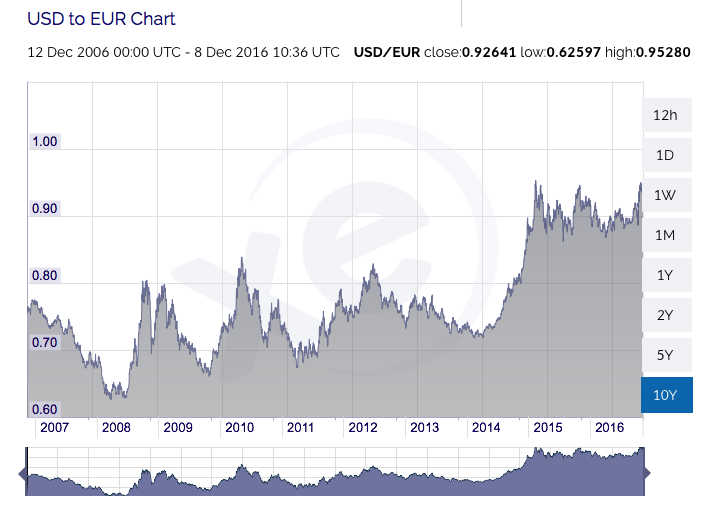
The value of the USD compared to the Euro from the years 2007-2016
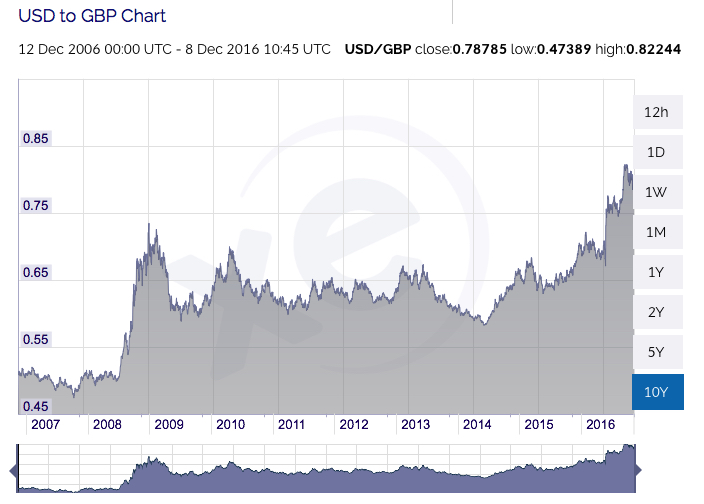
The value of the USD compared to the British Pound from the years 2007-2016
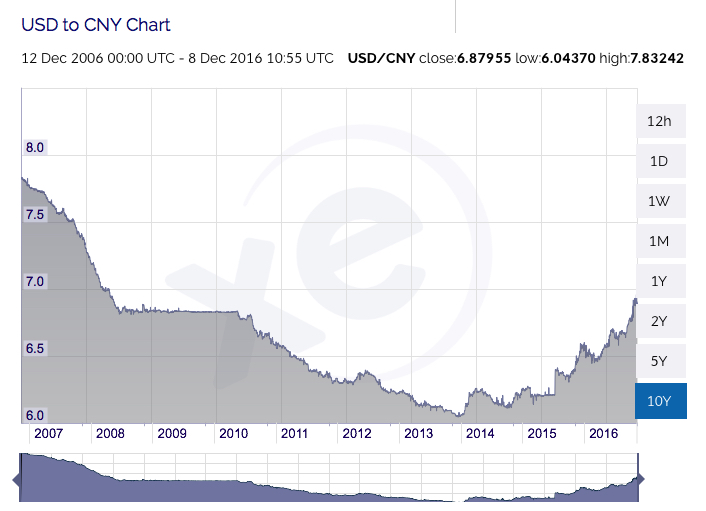
The value of the USD compared to the Chinese Renminbi from the years 2007-2016
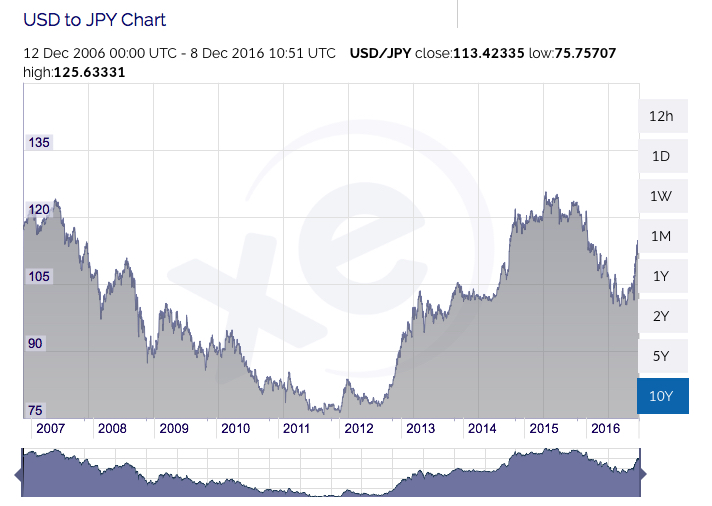
The value of the USD compared to the Japanese Yen from the years 2007-2016

The value of the USD compared to the Canadian Dollar from the years 2007-2016
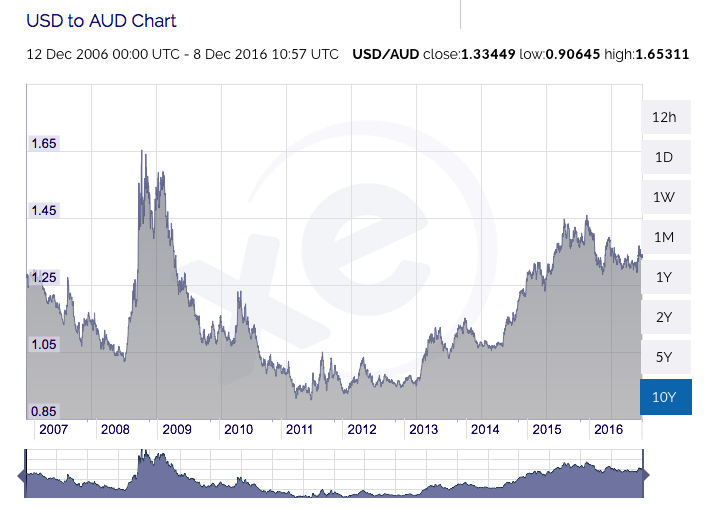
The value of the USD compared to the Australian Dollar from the years 2007-2016
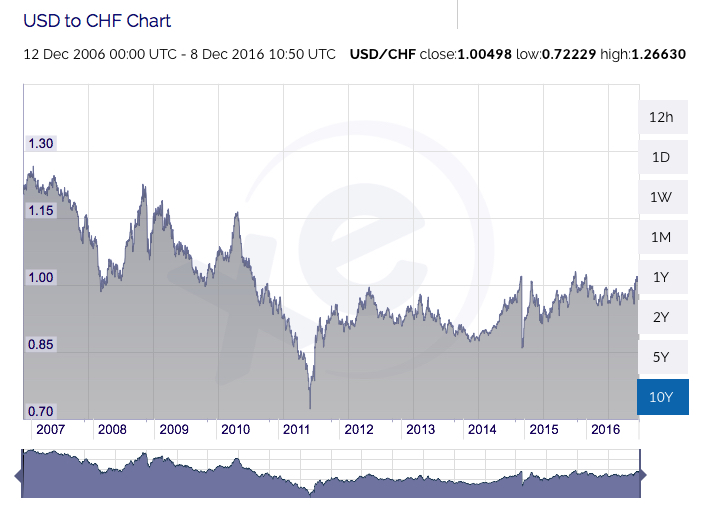
The value of the USD compared to the Swiss Franc from the years 2007-2016
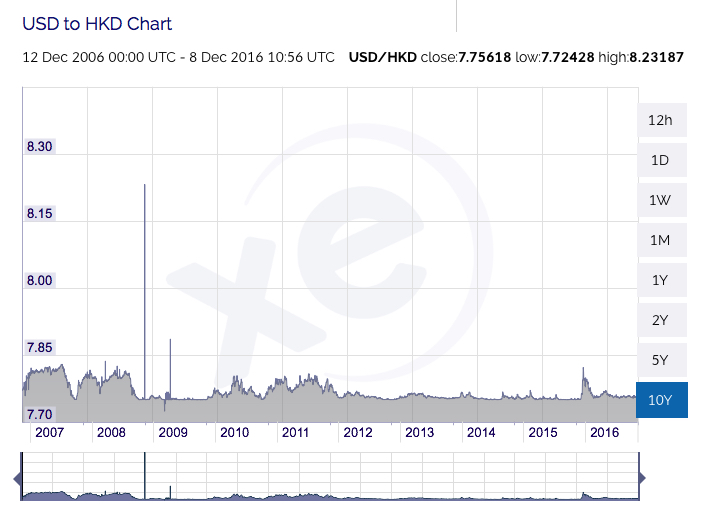
The value of the USD compared to the Hong Kong Dollar from the years 2007-2016
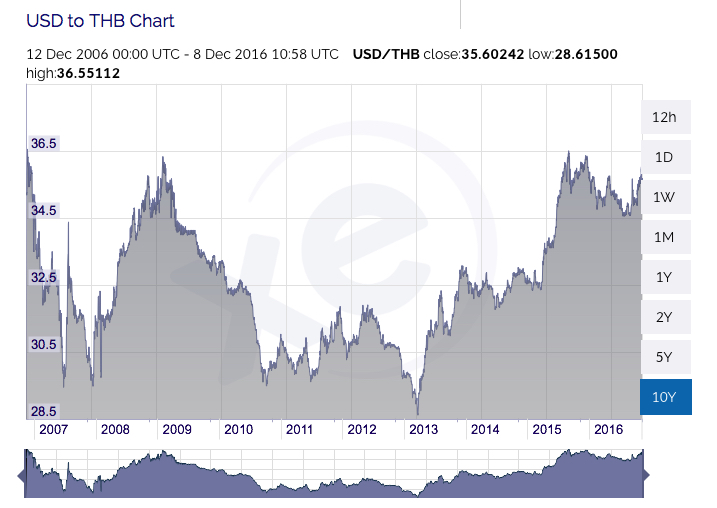
The value of the USD compared to the Thailand Bhat from the years 2007-2016
Liquidity
One last element to consider is liquidity. In the same way that we want diamonds to be more liquid, we also want a currency that is more liquid, and currently, the USD is the most liquid currency globally.
I would have liked to see Diamonds and other hard assets trade in Swiss Francs for example. The Swiss economy is healthier than the US per capita, and their debt/GDP is less than 16% compared to the US with 110%, or Japan with 220%. However, the Swiss Franc is less liquid and less available. We have to find a better balance.
What happens if the USA can no longer service its debt and defaults? How do we go about it then? What do you think?
Related Posts
Diamonds Should No Longer Be Priced Just in US Dollars
As economies around the world have changed dramatically and become more global concurrently with the US debt rising to its current levels, I suppose that it is irresponsible to keep trading diamonds only in US currency. I think that it should apply to many other various commodities, such as gold, oil, platinum, and all other basic consumption and manufacturing commodities as well. However, I will only address diamonds.
The question remains: in what currency should diamonds be priced? It would be tough to say, since all major currencies are valued against the US dollar. Some are being “monitored” and “controlled”, while others are allowed to fluctuate according to supply and demand. The fact that all major commodities trade automatically in US dollars gives the impression that the demand for US dollars is real, while in reality it may not be the case.
Many countries have slowly been decreasing their currency reserves of US dollars in favor of a more balanced basket of currencies. China is such a country. Who is right in their actions, China or the US? China has a strong arm in the valuation of their currency, while the US, which dominates the world in terms of size of economy, has debt that has ballooned to almost $20 trillion dollars.
I believe that the price of diamonds should follow a more balanced basket of currencies, which should rely on a country’s real wealth. I also believe that the pricing structure of diamonds should be a formula that includes the top 10 currencies changing hands.
What are the Top 10 Currencies Currently Dominating Global Trade?
According to Swift (the international entity enabling wire transfers), since August 2015, the USD (U.S. Dollar) has been dominating global trade with 44.82% of all global payments, followed by the EUR (the Euro) at a far second at 27.20%. In third place is the GBP (British Pound) at 8.45%, followed by the CNY (Chinese Renminbi) in fourth place at 2.79% (which also doubled since January 2014). Fifth place is held by the JPY (Japanese Yen) at 2.76%. The next 5 currencies are the Canadian Dollar, Australian Dollar, Swiss Francs, Hong Kong Dollar, and Thailand Bhat. All of these currencies trade at least 1% of global currencies payments each.
Let’s review how the top nine currencies have changed in value with the USD over the last 10 years.

The value of the USD compared to the Euro from the years 2007-2016

The value of the USD compared to the British Pound from the years 2007-2016

The value of the USD compared to the Chinese Renminbi from the years 2007-2016

The value of the USD compared to the Japanese Yen from the years 2007-2016

The value of the USD compared to the Canadian Dollar from the years 2007-2016

The value of the USD compared to the Australian Dollar from the years 2007-2016

The value of the USD compared to the Swiss Franc from the years 2007-2016

The value of the USD compared to the Hong Kong Dollar from the years 2007-2016

The value of the USD compared to the Thailand Bhat from the years 2007-2016
Liquidity
One last element to consider is liquidity. In the same way that we want diamonds to be more liquid, we also want a currency that is more liquid, and currently, the USD is the most liquid currency globally.
I would have liked to see Diamonds and other hard assets trade in Swiss Francs for example. The Swiss economy is healthier than the US per capita, and their debt/GDP is less than 16% compared to the US with 110%, or Japan with 220%. However, the Swiss Franc is less liquid and less available. We have to find a better balance.
What happens if the USA can no longer service its debt and defaults? How do we go about it then? What do you think?
Related Posts
- What Is So Extraordinary About The 2018 Argyle Tender?
- Do Collectible Cars Withstand Wealth Concentration Conditions and Requirements?
- Fancy Green Diamonds: Their Mystical And Hidden Value
- Of All Passion Investments That Sell At Auction, Do Buyers Spend the Most On Fancy Color Diamonds?
- If I Had A Crystal Ball, What Diamonds Would I Have Invested In 10 Years Ago?
Leave a Reply
You must be logged in to post a comment.
Diamonds Should No Longer Be Priced Just in US Dollars
As economies around the world have changed dramatically and become more global concurrently with the US debt rising to its current levels, I suppose that it is irresponsible to keep trading diamonds only in US currency. I think that it should apply to many other various commodities, such as gold, oil, platinum, and all other basic consumption and manufacturing commodities as well. However, I will only address diamonds.
The question remains: in what currency should diamonds be priced? It would be tough to say, since all major currencies are valued against the US dollar. Some are being “monitored” and “controlled”, while others are allowed to fluctuate according to supply and demand. The fact that all major commodities trade automatically in US dollars gives the impression that the demand for US dollars is real, while in reality it may not be the case.
Many countries have slowly been decreasing their currency reserves of US dollars in favor of a more balanced basket of currencies. China is such a country. Who is right in their actions, China or the US? China has a strong arm in the valuation of their currency, while the US, which dominates the world in terms of size of economy, has debt that has ballooned to almost $20 trillion dollars.
I believe that the price of diamonds should follow a more balanced basket of currencies, which should rely on a country’s real wealth. I also believe that the pricing structure of diamonds should be a formula that includes the top 10 currencies changing hands.
What are the Top 10 Currencies Currently Dominating Global Trade?
According to Swift (the international entity enabling wire transfers), since August 2015, the USD (U.S. Dollar) has been dominating global trade with 44.82% of all global payments, followed by the EUR (the Euro) at a far second at 27.20%. In third place is the GBP (British Pound) at 8.45%, followed by the CNY (Chinese Renminbi) in fourth place at 2.79% (which also doubled since January 2014). Fifth place is held by the JPY (Japanese Yen) at 2.76%. The next 5 currencies are the Canadian Dollar, Australian Dollar, Swiss Francs, Hong Kong Dollar, and Thailand Bhat. All of these currencies trade at least 1% of global currencies payments each.
Let’s review how the top nine currencies have changed in value with the USD over the last 10 years.

The value of the USD compared to the Euro from the years 2007-2016

The value of the USD compared to the British Pound from the years 2007-2016

The value of the USD compared to the Chinese Renminbi from the years 2007-2016

The value of the USD compared to the Japanese Yen from the years 2007-2016

The value of the USD compared to the Canadian Dollar from the years 2007-2016

The value of the USD compared to the Australian Dollar from the years 2007-2016

The value of the USD compared to the Swiss Franc from the years 2007-2016

The value of the USD compared to the Hong Kong Dollar from the years 2007-2016

The value of the USD compared to the Thailand Bhat from the years 2007-2016
Liquidity
One last element to consider is liquidity. In the same way that we want diamonds to be more liquid, we also want a currency that is more liquid, and currently, the USD is the most liquid currency globally.
I would have liked to see Diamonds and other hard assets trade in Swiss Francs for example. The Swiss economy is healthier than the US per capita, and their debt/GDP is less than 16% compared to the US with 110%, or Japan with 220%. However, the Swiss Franc is less liquid and less available. We have to find a better balance.
What happens if the USA can no longer service its debt and defaults? How do we go about it then? What do you think?
Related Posts
- What Is So Extraordinary About The 2018 Argyle Tender?
- Do Collectible Cars Withstand Wealth Concentration Conditions and Requirements?
- Fancy Green Diamonds: Their Mystical And Hidden Value
- Of All Passion Investments That Sell At Auction, Do Buyers Spend the Most On Fancy Color Diamonds?
- If I Had A Crystal Ball, What Diamonds Would I Have Invested In 10 Years Ago?
Leave a Reply
You must be logged in to post a comment.
